NCERT Solutions for Class 5 EVS Chapter 14 - When the Earth Shook
A Bad Dream
Imagine, being without a house in the cold winter! Fear and the cold kept us awake in the night. All the time we were worried that there may be another earthquake.Discuss and Write - Page no. 132
Q1. Have you or anyone that you know ever faced such difficulty?
Ans. No, but I heard it on the television news.
Q2. Who all helped at such a time? Make a list.
Ans. The list of the people who had provided help at that time is as follows:
(i) The neighbours helped each other.
(ii) People from the cities.
(iii) The local leaders.
(iv) The political leaders.
(v) Various non-government organizations in that area.
(vi) Doctors and nurses of the hospitals of that place.
(vii) Few shopkeepers
Discuss - Page no. 134
Q1. A lot of people from other places to Jasma’s village. Who were these people? In what ways would they have helped the villagers?
Ans. The people who came to Jasma’s village for help were:
(i) People from the cities.
(ii) Scientists, architects and engineers.
(iii) Non-government and Voluntary organizations
(iv) Some doctors
(v) State Minister and other political leaders
These people helped the villagers in a number of ways, such as:
(i) People from the cities with food, medicines and clothes. They also helped to put up the tents.
(ii) The scientists tried to find out which areas have more chances of having an earthquake and they gave an alarming signal to the villagers to keep them away from these places.
(iii) The engineers and architects showed them some special designs for houses that would not get much damaged in an earthquake.
(iv) The non-government voluntary organizations helped the people by providing them with food, clothes, tents to make huts etc.
(v) Doctors and nurses provided them with free first aid and treatment.
(vi) The state minister and other political leaders provided the people with various basic things like food grains, vegetables, compensatory money etc.
Q2. People in Jasma’s village rebuilt their houses with suggestions from the engineers. Will these houses be safer than before in case there is an earthquake again? Why?
Ans. Yes, these houses would be comparatively safer than before in case there is an earthquake. This is because these were now prepared according to the suggestions and designs explained by the engineers.
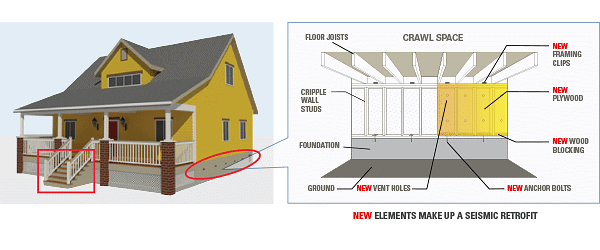
Q3. Think, if there were an earthquake where you live, would your house be a danger? What kind of damage could take place?
Ans. Yes, if there is an earthquake, where I live, my house would be in danger. The following damage could happen:
(i) The various household equipment such as TV, radio, utensils, eatables etc. Could get destroyed.
(ii) If there would be a very severe earthquake, even the people would get crushed under the fallen houses and die.
Q4. What will you do to save pet animals during a natural disaster?
Ans. I will prepare an emergency kit for my pet which consists of medical needs, water, food etc. along with the shelter.
Write - Page no. 134
Q1. Compare your houses with that of Jasma. List in your notebook what materials were used in making both houses.

Ans.
What will you do? - Page no. 134,135
People from the groups also made children in Jasma’s school practice what they should do in case there is an earthquake. This is what they said:
- If possible leave the house and go to open ground.
- If you cannot go out of the house, lie down under a strong thing like a table and hold on tightly so that it does not slip away. Wait until the shaking stops.
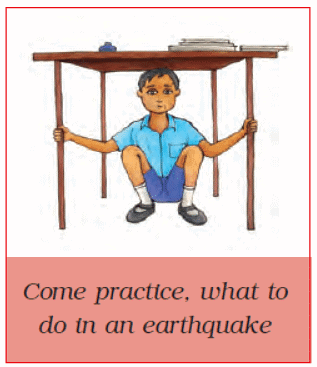 Q1. Have you been told in your school or anywhere else about what to do in case of an earthquake?
Q1. Have you been told in your school or anywhere else about what to do in case of an earthquake?
Ans. Yes, we were told in our school about what should be done in case of an earthquake. We were told to go out in an open place if possible or sit under a strong object like a table and hold it firmly.
Q2. Why do you think one should go under a table during an earthquake?
Ans. During an earthquake, the house or the building can collapse and the bricks etc. can fall on the people and injure them, even causing their death. Therefore, if we would sit under a strong object like a table and hold it firmly.
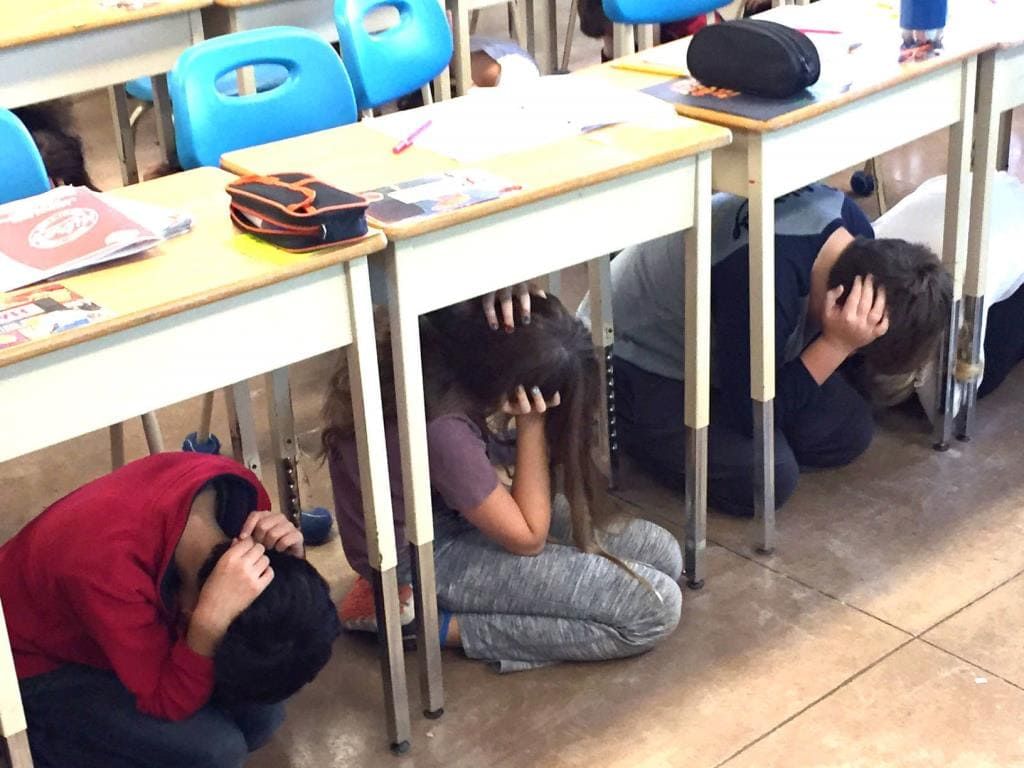
Who helped? - Page no. 135
Read this TV report on Bhuj Earthquake
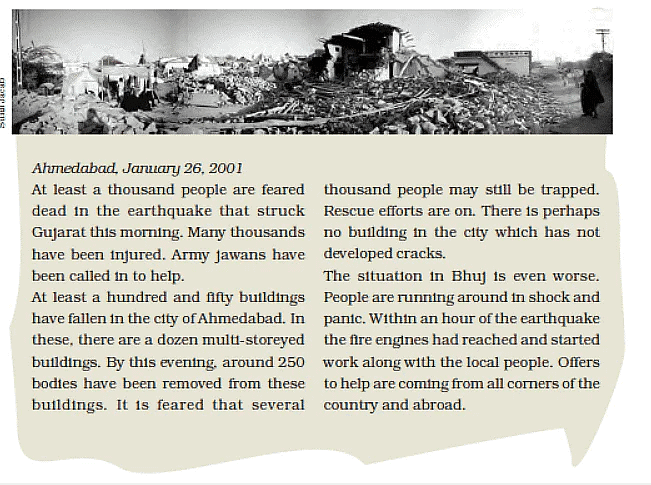
Write - Page no. 135
Q1. According to the TV reports, thousands of people were injured and some died in Gujarat. If the buildings had been made in a way that they would not fall in the earthquake, would the damage have been different? How?Ans. Yes, if the buildings there had been made earthquake-proof, the damage would have been lesser. The people would not have died under the buildings and the number of injured people would have also been lesser. The loss of the various belongings of the people would also have been lesser.
Q2. At times like this, when people have lost their homes and all their belongings, what kind of people would they need?
Ans. At times when people have lost their homes and their belongings, they would need the following help:
(i) Tent/canvas to prepare their huts
(ii) Clothes
(iii) Food, water, milk
(iv) Medicines and first aid treatment
Q3. In such situations whose help would be needed and for what? Write in your notebook.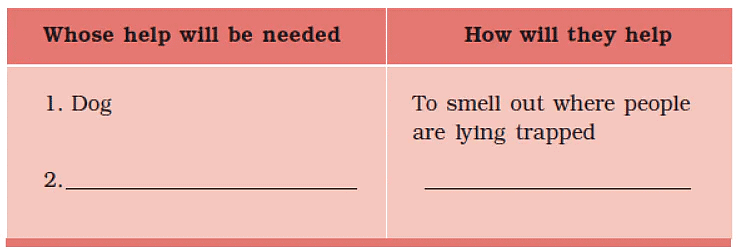
Ans.
Discuss - Page no. 136
Q1. Have you ever seen people in your area helping each other? When?
Ans. Yes, a few years back, a few houses in our area got burnt. At that time all the neighbours helped them and provided them with all possible support.
Q2. Why do people live together in a neighbourhood?
Ans. People live together in a neighbourhood because at the time of any big problem, danger or calamities like earthquake, flood, theft or major health problems etc. they can take help from each other.
Q3. Imagine, living in a place where there were no other houses or people around. How would it be? For example, whom would you play with? With whom would you celebrate festivals and special days? Would you be scared?
Ans. If my house would have been all alone in a place, then
(i) There would have been no one to help us during any problem, calamities, or disasters like earthquake, flood, fire, theft, major illness etc.
(ii) There would be no one with whom I could play.
(iii) There would be no one with whom we could celebrate various festivals and special occasions.
(iv) I would have felt scared also.
Your News Report - Page no. 137
Q1. Make your own report which mentions the following:
- Cause of the disaster, date and time.
- What kind of damage did it cause – to lives, belonging, livelihoods?
- Which people came forward to help? Which government offices or other groups?
Ans. New Delhi, Friday 28 Jan 2010
A major fire broke out on Thursday early morning in the slum area of Bawana. The incident occurred at around 4.30 am. The blaze was spotted in one of the Jhuggi’s due to a gas cylinder blast. The fire had spread to about 200 more Jhuggis.
Fire service officials said four fire-fighting tenders were pressed into action and the flames could be doused only after two hours. About 10 people died on the spot and more than 100 got severe injuries. The housed and the belongings of the people were completely burnt and destroyed. The area supervisor and district leaders came for help and support to the victim. Many non-government organizations also rendered support by providing the victims with clothes, utensils, food, drinking water, milk, etc. The government has declared to provide Rs. 2 lakhs to the family members of the deceased and Rs.50,000 to each family who has lost their houses, as compensation.
Q2. Have people in your area got affected by famine or drought? Find such reports of different countries in newspapers. Make your own report.
Ans. Odisha hit by drought
Thursday 2 nd July 2010
After a year Odisha has been hit by a severe drought again. More than 5,000 families living in the coastal area have been affected. Officials say the state has incurred a huge loss in its paddy crops worth more than 500 crores. There is a scarcity of food and drinking water in the affected area. The people are dying due to starvation.
The State Minister said that the government had taken all the measures it could to ensure that food and drinking water is available to those affected. Various NGOs have also come to provide help and support to the people by providing food, water, milk, clothes etc. to the affected people. A leading state environmentalist said the destruction of forest land and the lack of water conservation policy were two key factors responsible for the drought. The government has announced to pay Rs. 25,000 to the affected family, as compensation.
Q3. You may need some help from these in case of an accident or emergency. Find out and write their addresses and phone numbers. Add more names to this list.
Ans.
Difficult times - Page no. 137
Q1. Write a report with the help of the following words:
Floods, river water, injured people, food packets, rescue work, camps, dead bodies, dead animals floating in the water, houses underwater, aerial surveys ( to see the scene of the disaster from a plane), sad people, diseases spread by dirty water, homeless people, trapped people.
Ans. Guwahati, Aug1, 2005
The flood situation in Assam has worsened with the death of about 500 people in the last three days. Due to the heavy monsoons, the river water level of the adjoining Brahmaputra river has further risen above the danger mark. The Regional Meteorological Centre here warned of more rain and thundershowers.
An aerial survey of the place was conducted to estimate the loss. The area has about 8000 houses underwater, and two hundred dead bodies of men and animals floating in the water. The state government has opened 2500 temporary camps besides lodging the flood-hit, sad and homeless people in trying their best to provide help and support to the trapped people. They have been provided with food packets, drinking water, milk etc. Doctors are working voluntarily to provide free treatment to injured and ill people and also providing measures to prevent water-borne diseases.
The government has announced to pay Rs. 2 lakh to the family members of the deceased and Rs. One lakh to all the flood-hit families, as compensation.
What we have Learnt - Page no. 138
Q1. What type of difficulties are faced by people during floods? Look at the picture, what kind of a school have the children come to after the flood? Write down what people have to make their life normal again after the flood.
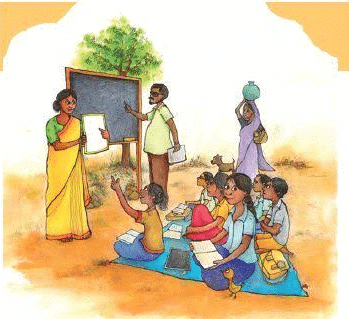
Ans. The following difficulties are faced by people during floods:
(i) Many people die.
(ii) Many people get injured.
(iii) Their houses and other valuable get destroyed.
(iv) Their farms are destroyed.
(v) A lot of food items are destroyed.
(vi) There is a scarcity of drinking water.
(vii) Waterborne diseases are spread.
(viii) The roadways and railways get, affected badly.
(ix) Schools, hospitals and other important public places get destructed.
It has been shown in the picture that after the floods, since the schools of the children have been destroyed, as a result, they have to study in a park or under a tree.
(i) Treatment of injured and diseased people.
(ii) Helping and supporting those people who have lost their family members/earning hands. This can be done by providing them with some compensatory money, loans or job etc.
(iii) The arrangement of safe drinking water and food for the people and take appropriate measures so that diseases could be prevented to be spread.
(iv) The roadways and railways should be brought back to normal.
(v) The schools of the children should be made functional again.
|
37 videos|410 docs|41 tests
|
FAQs on NCERT Solutions for Class 5 EVS Chapter 14 - When the Earth Shook
| 1. What causes earthquakes and how do they affect the earth? |  |
| 2. How can we prepare for an earthquake? |  |
| 3. What are the immediate steps to take during an earthquake? |  |
| 4. What long-term effects can earthquakes have on communities? |  |
| 5. How do scientists measure and report the strength of an earthquake? |  |

















